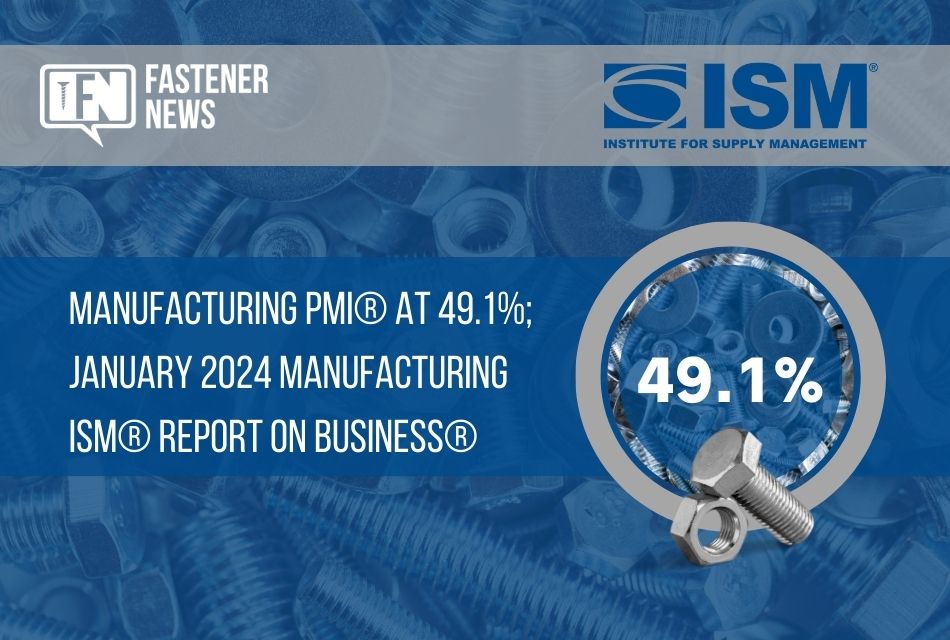
NEWS PROVIDED BY: Institute for Supply Management
01 Feb, 2024
New Orders Growing; Backlogs Contracting; Production Growing; Employment Contracting; Supplier Deliveries Faster; Raw Materials Inventories Contracting; Customers’ Inventories Too Low; Prices Increasing; Exports Contracting and Imports Growing
This report reflects the recently completed annual adjustments to the seasonal factors used to calculate the indexes.
TEMPE, Ariz., Feb. 1, 2024 /PRNewswire/ — Economic activity in the manufacturing sector contracted in January for the 15th consecutive month following one month of “unchanged” status (a PMI® reading of 50 percent) and 28 months of growth prior to that, say the nation’s supply executives in the latest Manufacturing ISM® Report On Business®.
The report was issued today by Timothy R. Fiore, CPSM, C.P.M., Chair of the Institute for Supply Management® (ISM®) Manufacturing Business Survey Committee:
“The Manufacturing PMI® registered 49.1 percent in January, up 2 percentage points from the seasonally adjusted 47.1 percent recorded in December. The overall economy continued in expansion for the 45th month after one month of contraction in April 2020. (A Manufacturing PMI® above 42.5 percent, over a period of time, generally indicates an expansion of the overall economy.) The New Orders Index moved into expansion territory at 52.5 percent, 5.5 percentage points higher than the seasonally adjusted figure of 47 percent recorded in December. The January reading of the Production Index (50.4 percent) is 0.5 percentage point higher than December’s seasonally adjusted figure of 49.9 percent. The Prices Index registered 52.9 percent, up 7.7 percentage points compared to the reading of 45.2 percent in December. The Backlog of Orders Index registered 44.7 percent, 0.6 percentage point lower than the 45.3 percent recorded in December. The Employment Index registered 47.1 percent, down 0.4 percentage point from December’s seasonally adjusted figure of 47.5 percent.
“The Supplier Deliveries Index figure of 49.1 percent is 2.1 percentage points higher than the 47 percent recorded in December. (Supplier Deliveries is the only ISM® Report On Business® index that is inversed; a reading of above 50 percent indicates slower deliveries, which is typical as the economy improves and customer demand increases.)
“The Inventories Index increased 2.3 percentage points to 46.2 percent from December’s seasonally adjusted reading of 43.9 percent. The New Export Orders Index reading of 45.2 percent is 4.7 percentage points lower than December’s figure of 49.9 percent. The Imports Index moved into expansion territory, registering 50.1 percent, 3.7 percentage points higher than the 46.4 percent reported in December.”
Fiore continues, “The U.S. manufacturing sector continued to contract, though at a marginal rate compared to December. Demand improved, output remained stable and inputs are accommodative. Demand moderated, with the (1) New Orders Index expanding at a respectable rate, (2) New Export Orders Index in a headwind and (3) Backlog of Orders Index remaining above 40 percent but still in fairly strong contraction territory at 44.7 percent. Also, the Customers’ Inventories Index contracted further, becoming more accommodative for future production. On balance, Output (measured by the Production and Employment indexes) expanded slightly, with a combined 0.1-percentage point upward impact on the Manufacturing PMI® calculation. Panelists’ companies maintained production levels month over month and continued head count reductions in January, with significant layoff activity. Inputs — defined as supplier deliveries, inventories, prices and imports — continued to accommodate future demand growth but are showing signs of stiffening. The Supplier Deliveries Index indicated faster deliveries for the 16th straight month, and the Inventories Index moved upward while remaining in moderate contraction territory. The Prices Index climbed into expansion (or ‘increasing’) territory as new pricing levels for 2024 went into effect.”
Two of the six biggest manufacturing industries (Transportation Equipment; and Chemical Products) registered growth in January.
“Demand remains soft but shows signs of improvement, and production execution is stable compared to December, as panelists’ companies continue to manage outputs, material inputs and labor costs. Suppliers continue to have capacity. Sixty-two percent of manufacturing gross domestic product (GDP) contracted in January, down from 84 percent in December. More importantly, the share of sector GDP registering a composite PMI® calculation at or below 45 percent — a good barometer of overall manufacturing weakness — was 27 percent in January, compared to 48 percent in December, and 54 percent in November. Among the top six industries by contribution to manufacturing GDP in January, two (Machinery; and Computer & Electronic Products) had a PMI® at or below 45 percent, one fewer than in the previous month,” says Fiore.
The four manufacturing industries reporting growth in January are: Apparel, Leather & Allied Products; Textile Mills; Transportation Equipment; and Chemical Products. The 13 industries reporting contraction in January — in the following order — are: Wood Products; Machinery; Plastics & Rubber Products; Nonmetallic Mineral Products; Furniture & Related Products; Computer & Electronic Products; Fabricated Metal Products; Petroleum & Coal Products; Food, Beverage & Tobacco Products; Electrical Equipment, Appliances & Components; Paper Products; Miscellaneous Manufacturing; and Primary Metals.
WHAT RESPONDENTS ARE SAYING
- “The start of 2024 looks good. Sales are above expectations, and costs are mostly stable. A few commodities are up in cost due to supply shortages. Many previously short commodities market positions have corrected themselves. There is a real short-term increase in the cost of international freight.” [Chemical Products]
- “The commercial vehicle market appears to be retracting a bit in 2024 compared to last year. Forecast sales have decreased slightly in most product segments, with only limited growth related to customers’ competitive sourcing and moves to new technology. Most supply chains, including for semiconductors, have stabilized, with the only major escalation now being transit through the Red Sea.” [Transportation Equipment]
- “Business continues to stabilize. Cash flow will be tight in 2024.” [Food, Beverage & Tobacco Products]
- “U.S. economic outlook is affecting customer orders, and the current backlog is quite low compared to past quarters. Waiting on potential improvements from the CHIPS and Science Act.” [Computer & Electronic Products]
- “December sales were very strong but slower for the first part of January, as was expected. We expect to see steady sales going forward, if the (U.S. Federal Reserve) continues to hold rates and suggests a rate cut in the future.” [Machinery]
- “Good start to the year. We had budgeted a 3.5-percent increase over 2023. We expect it to be a challenging year. Currently, orders are positive in our automotive OEM and automotive aftermarket business. Our industrial business sector is looking weak at the moment. Still expect to achieve budget forecasts through the first quarter. (We) feel January is running high for automotive because at the end of December, many OEMs cancelled the last few weeks of orders to reduce inventory levels.” [Fabricated Metal Products]
- “Order backlog, which was at historically high levels, is diminishing due to supply chain improvements and slight slowdown of orders.” [Miscellaneous Manufacturing]
- “Demand continues to be slow. Reduction from the second half of 2023 has continued into this year. We are adjusting production to match demand.” [Electrical Equipment, Appliances & Components]
- “Current industry conditions are positive; however, a note of caution as we see potential headwinds with downward price movements in the coming months.” [Primary Metals]
- “Remarkable slowdown in business in December. January has picked up, but not to previous-year levels.” [Textile Mills]
Read full release: ISM
RELATED CONTENT:
Fastener News, Fastener News Desk, Fastener News Podcast, Manufacturing, Press Releases

















